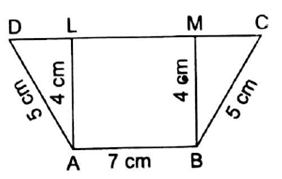In the adjoining figure, ABCD is a trapezium in which AB ‖ DC; AB = 7 cm; AD = BC = 5 cm and the distance between AB and DC is 4 cm. Find the length of DC and hence, find the area of trap. ABCD.

Given
AB = 7 cm
AD = BC 5 cm
AL = BM = 4cm (height)
DC = ?
Here in the given figure AB = LM
![]() LM = 7 cm ------------1
LM = 7 cm ------------1
Now Consider ![]() ALD
ALD
By Pythagoras theorem
AD2 = AL2 + DL2
52 = 42 + DL2
DL2 = 5 2 - 42 = 25 – 16 = 9
![]() DL = 3 cm --------------2
DL = 3 cm --------------2
Similarly in ![]() BMC
BMC
By Pythagoras theorem
BC2 = BM2 + MC2
52 = 42 + MC2
MC2 = 5 2 - 42 = 25 – 16 = 9
![]() MC = 3 cm --3
MC = 3 cm --3
![]() from 1 2 and 3
from 1 2 and 3
DC = DL + LM + MC = 3 + 7 + 3 = 13 cm
We know that area of trapezium is ![]() x (sum of parallel sides) x height
x (sum of parallel sides) x height
![]() Area of trapezium =
Area of trapezium = ![]() x (AB + DC) x AL
x (AB + DC) x AL
= ![]() x (7 + 13) x 4 = 40 cm2
x (7 + 13) x 4 = 40 cm2
![]() Area of trapezium ABCD = 180cm2
Area of trapezium ABCD = 180cm2
6